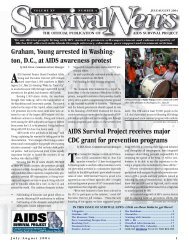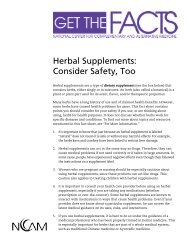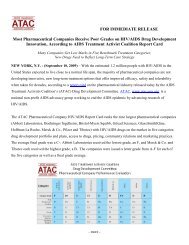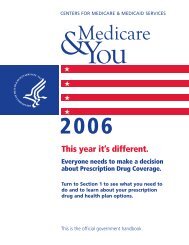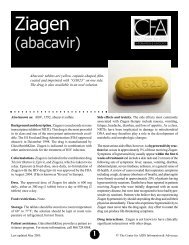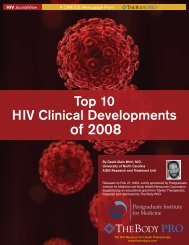PDF (2 MB) - National Institute on Drug Abuse
PDF (2 MB) - National Institute on Drug Abuse
PDF (2 MB) - National Institute on Drug Abuse
You also want an ePaper? Increase the reach of your titles
YUMPU automatically turns print PDFs into web optimized ePapers that Google loves.
2NIDA RESEARCH REPORT SERIES<br />
amphetamine, and was used<br />
originally in nasal dec<strong>on</strong>gestants<br />
and br<strong>on</strong>chial inhalers. Like<br />
amphetamine, methamphetamine<br />
causes increased activity and<br />
talkativeness, decreased appetite,<br />
and a general sense of well-being.<br />
However, methamphetamine<br />
differs from amphetamine in<br />
that at comparable doses, much<br />
higher levels of methamphetamine<br />
get into the brain, making<br />
it a more potent stimulant drug.<br />
It also has l<strong>on</strong>ger lasting and<br />
more harmful effects <strong>on</strong> the<br />
central nervous system.<br />
Methamphetamine is a<br />
Schedule II stimulant, which<br />
means it has a high potential<br />
for abuse and is available <strong>on</strong>ly<br />
through a prescripti<strong>on</strong>. It is<br />
indicated for the treatment of<br />
narcolepsy (a sleep disorder)<br />
and attenti<strong>on</strong> deficit hyperactivity<br />
disorder; but these medical uses<br />
are limited, and the doses are<br />
much lower than those typically<br />
abused.<br />
What is the<br />
scope of<br />
methamphetamine<br />
abuse in the<br />
United States?<br />
NIDA’s Community<br />
Epidemiology Work<br />
Group (CEWG), an early<br />
warning network of researchers<br />
that provides informati<strong>on</strong> about<br />
the nature and patterns of drug<br />
abuse in 21 major areas of the<br />
Primary Methamphetamine/Amphetamine Admissi<strong>on</strong><br />
Rates per 100,000 Populati<strong>on</strong> Aged 12 and Over<br />
1992 1994<br />
1999 2002<br />
Source: Treatment Episode Data Set (TEDS), SAMHSA.<br />
U.S., reported in January 2006<br />
that methamphetamine c<strong>on</strong>tinues<br />
to be a problem in the West,<br />
with indicators persisting at high<br />
levels in H<strong>on</strong>olulu, San Diego,<br />
Seattle, San Francisco, and Los<br />
Angeles; and that it c<strong>on</strong>tinues<br />
to spread to other areas of the<br />
country, including both rural<br />
and urban secti<strong>on</strong>s of the South<br />
and Midwest. In fact, methamphetamine<br />
was reported to be<br />
the fastest growing problem in<br />
metropolitan Atlanta.<br />
According to the 2005 <str<strong>on</strong>g>Nati<strong>on</strong>al</str<strong>on</strong>g><br />
Survey <strong>on</strong> <strong>Drug</strong> Use and Health<br />
(NSDUH), an estimated 10.4 milli<strong>on</strong><br />
people age 12 or older (4.3<br />
percent of the populati<strong>on</strong>) have<br />
tried methamphetamine at some<br />
time in their lives. Approximately<br />
1.3 milli<strong>on</strong> reported past-year<br />
Incomplete Data







